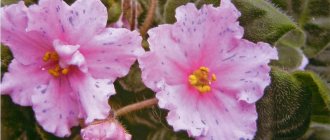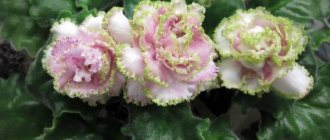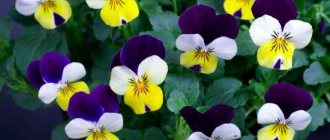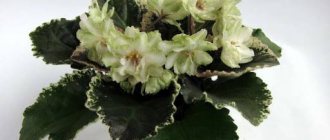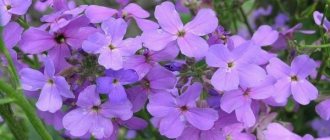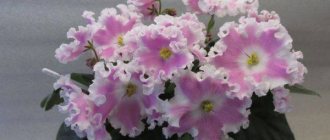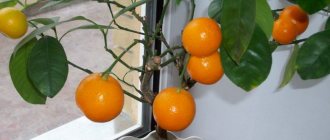Violets are considered capricious plants, and not every amateur gardener can find a common language with them the first time. It is quite difficult to find such a place on the windowsill so that the delicate leaves of these flowers do not get scorched from the summer heat. The ideal location for them is considered to be eastern and northern windows, but it often happens that even in ideal conditions, the violet refuses to bloom, and its leaves fade. It is even more difficult to propagate a plant, especially if it is a rare variety. The cuttings rot in water or dry out without producing offspring.
But this is not the case with the antique Paul Bunyan violet. This variety may have stood on the windowsills of our grandmothers, delighting them with its flowering. The flower is very unpretentious, it is able to grow in almost any conditions: in bright sun or in almost complete darkness. Of course, its small double inflorescences are difficult to compete with chic modern hybrids, but with its vitality it is winning more and more fans. The flowers of the Paul Banyan violet come in several shades: from lilac-violet to almost blue. This classic color looks equally good in any interior.
Features of the variety
Even a novice florist who has not previously been familiar with the agricultural technology of violets will be able to grow the Saintpaulia variety Paul Banyan and bring it to flowering. Improper watering, drying, insufficient lighting - it can withstand any adversity. Of course, with this variety you won’t be able to train yourself to care for other, more capricious violets. But decorating your windowsill with an abundantly flowering large plant is a must.
Saintpaulia Paul Bunyan (Storytella) has small, approximately 2.5 cm in diameter, lilac flowers with a slight shine, in the shape of a star. Additionally, they are decorated with venous veins. The leaves are quite large, light green in color, on long petioles, and heavily pubescent. The rosette is a standard size and grows very quickly: the flower is often divided into several rosettes. Because of this, the plant has to be replanted frequently to separate the children. The peduncles are tall, but in insufficient light they hide under the leaves. It blooms for a long time, throughout the season, sometimes even in winter.
The role of breeders in breeding varieties
And although many may think that selection work is complicated, it can be done by an ordinary person who has minimal knowledge in the field of biology.
Thanks to breeders, it has become possible to obtain numerous varieties that differ in color, type of flowers, and leaves. In addition, breeders obtain varieties that are grown under certain conditions . Thus, each gardener can choose the best option for himself, taking into account experience and personal preferences.
Propagation of Saintpaulia Paul Banyan in a jar of water
Violets can be propagated by dividing the bush or leaf cuttings at any time of the year, but best in the spring. They take root easily even in water, and often produce babies along the stem. The leaf needs to be cut with a sharp knife at an angle of 45 degrees, but the cuttings take root well, even if they are simply broken off from the bush and stuck in the ground. It is advisable not to cut off a shoot that is too long; 4 cm will be enough. When using the water method, the first roots appear after 3 weeks. If there are not too many leaves for violet propagation, it is advisable to play it safe and make a special “holder” for the leaf, which will not allow the bottom part to touch the bottom of the jar. To do this, take a regular sheet of paper, make a cut in the center and put it on top of the container, wrapping it with twine.
Features of flowering, growth and reproduction
How long does it take to grow an adult plant?
Saintpaulia goes through several stages :
- 3-4 weeks - first roots on the cuttings;
- 5-6 weeks - babies are formed;
- 3 months - the starter is formed. Only during this period does the plant need nitrogen fertilizing;
- 8-11 months - first flowering.
How are varietal characteristics transmitted?
Propagation procedure using leaf cuttings:
- Take a healthy leaf with a long stem;
- Cut off the top of the leaf;
- We root the cuttings in a small pot;
- Cover with a greenhouse;
- The variety will produce babies in 4 weeks.
What do flower stalks look like?
Peduncle variety:
- Middle length;
- Sturdy;
- Light green;
- Each has 3-4 flowers.
This variety has strong peduncles.
Is it possible to achieve cap flowering?
There are many flower stalks, double flowers form a beautiful bright head .
Bud lifespan
The duration of flowering with proper care is from three weeks to six months.
Cuttings in soil
You can do it differently by planting the cuttings directly in the ground or in a peat tablet. Usually such leaves are covered with a bag, creating greenhouse conditions, but this is not necessary for the Paul Bunyan violet. It is enough to pour boiling water over the soil or peat tablet for disinfection, cool it and place the cut cutting there. Sometimes, in order not to replant the baby, gardeners plant the leaf directly into the pot, but then they will have to wait a long time for the first flowering, because the young plant will spend energy growing roots until it fills the entire volume of soil. That is why they try to take small containers for planting young violets, for example ordinary transparent plastic cups. The roots and the amount of moisture remaining in the soil are visible in them, so it will immediately be clear when to water the flower. If the fear of losing a plant cutting is too great, you can cover it with a jar on top or put it in a greenhouse. But then the plant will need to be gradually accustomed to dry air, removing the can for a while and increasing the interval.
Reviews
Konstantin. “The variety is a little demanding to care for and needs constant supervision. After rejuvenation, I began to shed leaves and immediately produced buds. I had to cut off the flower stalks so as not to completely deplete it. Now she has already recovered, and the greenery has grown and a fresh bouquet of flowers has come out.”
Catherine. “My rosette bloomed very young and immediately produced a small cap. I was very doubtful before purchasing, since I have a slightly similar variety. I noticed one disadvantage of the rosette for myself: the leaves seem to be wrinkled or limp, but I think this may still go away as they grow older.”
Zinaida Petrovna. “On the purchased sheet I received a couple of children at once. One had the imprudence to put it on the wick from childhood, and it froze, after which it slowed down in growth. The second one bloomed safely at 9 months using classic watering. As soon as it blossomed, I put it on the wick, and it went crazy with happiness. Immediately, almost without rest, it produced a bunch of new flower stalks. The variety has a minus - the leaves are somewhat curled and shaggy. But this is compensated by flowering.”
Reproduction by dividing the bush
One of the features of the blooming violet Paul Bunyan is the constant formation of children on the mother bush. Because of this, the plant becomes deformed and loses its attractive appearance, so it requires regular replanting with separation of the shoots. The cut babies are often without roots, but they can be turned into full-fledged violets by cleaning the trunk, dipping it in a root enhancer and placing it in a water bottle. It is important that the growing point is not flooded, otherwise the plant will rot. Due to limited air access, the water in the tank must be changed regularly. When the roots appear, the violet is transplanted into the ground. Children with roots are already young plants: they can simply be separated from the mother plant and transplanted into another container. The plant is placed on a light windowsill and watered into a tray with settled water at room temperature. You can feed after a month.
Air humidity
Humidity is also a very important factor for Violets, because... The native habitats of these plants have saturated and high humidity. In room conditions, as a rule, the air humidity is not high enough and is 30%. For room conditions, it will be quite comfortable to have a humidity level of 50%; these are conditions under which “Violets” do not experience a deficiency of moisture in the air. The kitchen window sill is an ideal habitat for the plant; the air humidity in the kitchen is higher than in other rooms. Also, do not forget about the fact that “Violets” do not like drafts, and spraying with a spray bottle to increase the humidity level.
Soil for violets
A special soil mixture for Saintpaulias can be purchased at a flower shop or prepared independently by mixing one part of sand, peat and 4 parts of leaf soil. Sometimes coniferous soil and raising agents are added: perlite, vermiculite. Perlite is better suited because it does not retain excess moisture. The soil must be nutritious so that the violet has the strength to bloom. Some gardeners, in order to make it easier for themselves to care for a large collection, use “wick watering”. It allows you to protect plants from waterlogging or drying out of the earthen coma.
Violet BR-Arctic (Burkatsky)
BR-Arctic is a semi-miniature indoor violet that belongs to the genus of hybrid Saintpaulias, from the Gesneriev class . The variety was developed by the married couple of breeders S. and N. Burkatsky in 2015.
The rosette is even and neat, but tends to twist the leaves in the light and slightly stretch the cuttings. The shape of the leaves is oval, slightly pointed at the ends. The color is light green with a light green underside.
The flowers are large , rather even huge, in relation to the size of the rosette and reach 5-5.5 cm. The flowers are simple in shape, slightly bell-shaped.
The main color is white, and along the edge and in the center there is a border and a blue eye, from which small stains can be seen on the main tone.
Sometimes during reproduction it can give sport . The phenomenon is rare, but still possible, an example of the sport in the photo below.
This sport has completely blue flowers and leaves with chimeric variegation, which have retained only the shape of the mother plant.
Wick watering
You can make a wick when planting a plant using a special cord. Along it, as much moisture will rise to the roots of the plant as is necessary for normal growth and development. The main condition: make a special soil without adding soil, otherwise the violets may die. For wick irrigation, use a mixture of peat, vermiculite and perlite. Sometimes coconut substrate is added. A cord rolled into a ring is placed at the bottom of the pot, and its tip is brought out through the hole. Then soil is poured on top and a flower is planted in it. You need to place the plant in a pan of water so that the soil is saturated, and then in a container with water, where the other end of the cord will be located. All that remains is to regularly add liquid and nutrient solutions, because perlite and moss do not contain the microelements necessary for violets. The disadvantage of this method is that in winter such plants will require additional heating: the water in the containers will greatly cool the root system, and this can cause rotting of the roots and rosettes.
Transplant rules, rejuvenation
Saintpaulia needs to be replanted once a year.
Signs that it’s time to replant Saintpaulia:
- The plant has an unsightly stem that requires deepening;
- The roots emerged from the drainage hole;
- There is a suspicion of stagnation of water in the pot (the flower is flooded);
- The violet grows in the same substrate for more than two years;
- Signs of nutritional deficiency have appeared.
order :
- Remove the roots with a lump of soil from the pot;
- Carefully remove the old substrate;
- Cut off excess leaves, old or diseased roots;
- Place the roots in fresh soil;
- When replanting a violet, the volume of the pot is left the same;
- After a day, water the plant and add soil.
When replanting a violet, be very careful; the flower and its roots can be easily damaged .
Saintpaulia must be regularly rejuvenated . This should be done when the plant reaches the age of 2.5-3 years. Otherwise, the plant will stop blooming or the flowers will be small.
ATTENTION! To revive a violet, the growing point with two tiers of leaves - the “head” - is cut off from an old plant, then it is rooted in water or a greenhouse.
Selection of a pot for violets
The pots for violets are chosen to be small in size; its diameter should correspond to approximately 2/3 of the rosette. In pots that are too large, the plant will take a long time to grow root mass and greenery, rather than bloom. In addition, too much soil can lead to overwatering of the plant if the roots of the flower do not have time to absorb water. But for growing Paul Bunyan violets, it is better to take slightly larger containers than for other violets, because this variety grows very quickly and can produce many children.
Saintpaulias do not like clay pots because they get very wet, and high humidity increases the risk of infection with fungal diseases. It is better to take a light plastic container that does not heat up in the sun and does not become saturated with moisture. Violets are not planted in glazed heavy pots because they do not “breathe”.
Advice from experienced flower growers
Caring for violets is not difficult.
Experienced flower growers note:
- The variety grows quickly; it needs to be planted more often to make the plant look compact and neat;
- Paul Bunyan doesn't like other plants to be too close and touch his leaves. They may rot;
- You should not use clay pots for Saintpaulias. Clay is hygroscopic, it absorbs moisture, which is bad for the roots and the plant itself;
- You can establish contact with any plant. Violets are especially sensitive to a person's mood and feelings. Positive and negative emotions affect the well-being and appearance of flowers.
Caring for Saintpaulia Paul Bunyan
This variety of violet is extremely undemanding in terms of keeping conditions, but for abundant flowering it is advisable to provide it with a bright windowsill, without access to direct sunlight, and with enough space. The comfortable temperature for the Paul Bunyan violet is 20 degrees Celsius. Water the plant moderately, with warm water in a tray, but it will survive surface watering, although this often rots other varieties. The main thing is that liquid does not get into the center of the outlet. The plant cannot be sprayed because the leaves are pubescent - then spots appear on them. In summer, violets are fed with complex fertilizer or organic matter. Replant as needed when the flower grows. Diseased and damaged leaves are removed, leaving a small stump; the sections can be treated with activated carbon. Caring for the Saintpaulia variety Paul Banyan is quite simple and does not cause difficulties even for novice gardeners. The plant is rarely damaged by pests and practically does not get sick.
Violet Blueberry dessert (K. Morev)
Violet Blueberry Dessert Moreva uzambarica belongs to the botanical genus Saintpaulia , order Lamiaceae, Gesneriaceae family.
Violet flowers Blueberry dessert (K. Morev) are double or semi-double, the center of the corolla and the edge are white, the center of the petal is purple . The edge of the petals is wavy.
The leaf blades are simple, green or dark green in color . The socket is standard. The leaves tend to droop.
The Blueberry Dessert variety was developed by Konstantin Morev.
Violet Paul Bunyan: description, cultivation features and reviews
In winter, this variety can withstand some shading, but it is better to place it under lamps if possible. Then the violet will delight its owners with new buds for most of the year. Although, by modern standards, flowering is considered inconspicuous, few varieties can boast of such abundant and long-lasting flowering. Judging by the descriptions and reviews of the Paul Bunyan violet on plant lovers forums, this variety is unpretentious and profusely flowering, but it does not like close proximity to other plants. When leaves come into contact with an obstacle, they can rot. It is advisable to place the flower in a place where there are no drafts, and the distance to neighboring pots or other objects is at least 3 cm. This variety does not require any special growing conditions; even with minimal care, the Saintpaulia variety Paul Banyan will delight the owner with abundant flowering and a beautiful even rosette of a pleasant green color.
Description of species by breeder with photo
Check out the photo descriptions of the varieties: Apple Orchard, Tsar Peas, Rustle of Waves and Ness Orange Pekoe
D.Ness - Ness Orange Pekoe
Violets are large, double or semi-double. Their color is coral. During flowering, an effective bouquet is created against the background of an even display variegated rosette. The shape of the violet flower is clearly defined. 3-5 flowers are formed on one peduncle. taking into account the conditions of maintenance, the flowers can be bright coral or coral-fawn.
The peculiarity of the variety is that on the same rosette the brightness of flowering can be different. Characterized by long and frequent flowering. The rosette is self-forming. The variegation is pink-cream and looks very bright on young flowers. At elevated temperatures, variegation may disappear.
But as soon as the rosette is placed in a cooler place, brightly colored variegated leaves again form from the center of the rosette. The flower responds positively to natural light, although it grows and blooms well under artificial light. Propagated by cuttings, produces many children.
A. Kuznetsov – SK-Apple Garden
Semi-double white flowers. Its foliage is light green and has pointed edges. The rosette is beautiful, 9-14 cm. The flowers are white and semi-double. Only at the edges of the petals is there pink color. The size of the flowers is 2.5-3 cm. During flowering, a lush bouquet is formed on the peduncles. Peduncles are short, strong and stable.
The pink and white cap almost completely covers the rosette. The petals are characterized by increased density. Flowering duration is 1.5-2 months. Instead of old faded flowers, new ones come. To prolong flowering, you need to place the pot in a cool room. If the temperature is exceeded, the tips of the upper petals turn crimson.
The variety reproduces quickly and blooms early. Keep on wick watering, avoid overfeeding. If the leaves of the rosette darken, the petals will begin to float with a crimson border.
Tatiana Valkova
WAT Snow White
Large flowers that look like stars. The main color is pink, and along the corrugated edge there is a bright crimson edging. The rosette is neat and consists of green leaves. They are long with wavy edges. Flowering lasts 3 months. At this time, the flowers are lush and bright.
In terms of care, the plant is not picky; regular watering and natural light remain important for it .
King Pea
The leaves are large, smooth, with a cream edging. The rosette is neat, the leaves are slightly inclined downwards. The petals are dark blue, and bright crimson peas are scattered across their surface. The petals have a beautiful white and slightly wavy edge. Flower size is 6-7 cm.
Flowering is abundant and long lasting. The variety prefers warmth. If you keep it cold, the flowers will not be as bright.
G. Lazarenko – Rustle of waves
The flowers are large and simple. They are semi-double and light blue in color. The edges of the petals are wavy and have a white corrugated edge. The leaves are bright green with wavy edges. They are large, corrugated and rigid, but quite fragile.
You need to be extremely careful with them, as one wrong move and the leaves will quickly break off. The petioles of the leaves are long, the rosette is slightly loose. Flowering occurs already in the first year after planting. The peduncles are long, but they cannot withstand the weight of the flowers. 4-6 buds are formed on peduncles.
In terms of cultivation, the variety is not capricious. Overwatering has a detrimental effect on plant development. The flower does not require bright lighting and does not tend to lift its leaves upward.
K. Stork
Emergence
A single or semi-double red pansy with a white furrowed edge. The flower consists of 5 petals. The color is dark pink, and the edges of the petals are wavy and white. The leaves are wavy along the edges. The underside of the leaves is red, and the outside is dark green, covered with light fluff.
Quilting Bee
This variety allows you to grow double, corrugated white flowers. There is a slight lavender shadow on the petals. The flower size is 3 cm. The leaves are quilted, bright green and slightly wavy. The rosette is loose, the leaves are directed in different directions. The flowers are white-lilac, lush and voluminous.
Their size is 3 cm. The petals are delicate with a carved edge. Every flowering is a surprise for the gardener. The fact is that there are two lines: one is light and the other is darker. The main color is lilac, but it can be of varying degrees of saturation.
The bloom looks like a foamy lace bouquet. The opening of the buds occurs slowly. In terms of cultivation, the variety is undemanding. It does not grow very quickly, but needs regular and abundant watering.
B. Kostsevyat – Valentina Tereshkova
This plant forms a rosette of green leaves. Its size is 16 cm, and the leaves are 4 cm. The flowers are small, size 5 cm. The petals are white-blue in color, the edges are wavy. Flowering is lush and long lasting. With age, the size of the rosette increases, and the flowering becomes lush and beautiful.
D. Denisenko
DN - Young French girl
Large, bright purple pansies with a wide, light and heavily ruffled border. Variegated rosette. The leaves are dark green, wavy along the edges. 4-5 flowers are formed on one peduncle. Flowering is lush and long lasting.
At this time, the flower stalks cannot withstand the weight of the buds and bend slightly. Keep the flower in a cool place, in natural light and with regular watering.
DN-Rozheva Konvaliya
The flower looks like a bell. The main shade of the petals is pure pink, and there is a purple edge around the edges. The petals are corrugated and dense. Leaves are dark green.
They are wide and have a pointed end. Grows well in natural light and requires regular watering. Flowering is abundant and frequent.
I. Nizkous – Wedding bells
The leaves are small but wide. They are dark green in color, with pronounced veins. The flowers are small in size - 3 cm. The main color is soft pink, and at the edges there is a blurry bright pink color. The petals are delicate and corrugated at the edges.
N. Kozak – A feeling of celebration
The flowers are bright lilac. They are lush and their edges are corrugated. Features of the variety are the interesting color of the leaves. Their main color is dark green, with light blurry spots scattered throughout it. The variety is distinguished by strong peduncles.
Flowering is long and lush. When all the buds bloom, a colorful bouquet is formed against a background of light green leaves. In terms of care, the plant is not demanding:
- daylight;
- regular watering;
- maintaining temperature conditions.
O. Aksenkina – Deo Marzipan
The flowers are beige-pink. They are shaped like marzipan roses. The leaves are dark green, pointed at the tip. They bend over the pot, looking in different directions. The plant feels great under a lamp, on a windowsill and in the shade. The size of the flowers is 3-4 cm. There are 4-5 of them on the peduncle.
Flowering is lush and abundant. The flowers last a long time. Since the flower stalks are weak, the flowers fall on the foliage .
O. Kosobkova – Watch
This variety is characterized by large double and semi-double flowers. They are white with cherry highlights and a thin wavy green border around the edges. Their size is 3-4 cm. The rosette is smooth and medium green. The leaves are wavy and wide. Flowering lasts a long time, and you can see it after transplantation in 5-7 months.
R. Sorano
Sassy Sister
The leaves are light green, wavy at the edges. The diameter of an adult rosette is 10-17 cm. The flower is densely double, dark pink in color. There is fringe along the edges. The buds are presented in bronze color. Up to 20 flowers are formed on one peduncle.
This variety of violets has 3 varieties:
- Dark pink flowers.
- White with a slight pink tint.
- Soft pink with a wide white edge and jagged edges of the petals.
Flowering is abundant and long lasting. An adult rosette forms 5-7 flowers on peduncles. All flower stalks are directed in different directions.
Already 9-12 months after planting, the plant blooms. Grows well on top and wick watering.
Leding Lady
The foliage is medium green, quilted and serrated. The rosette of the flower is large and easily formed, but the petioles tend to elongate. The flowers are pink, pointed. They have lace edges and double edging: a ruffled thin white edge and a lilac frame. During the first flowering, the flowers are not double.
Flower size is 5-6 cm. Flowering duration is 2 months. And although the peduncles are long, they cannot withstand the weight of the flowers and droop. Violets are grown in natural light. If it is strong, then burnt spots will form on the leaves.
Svetlana Dzhura (Pikalenko) – Juice Adelina
The flowers are large, semi-double. The main color of the petals is pink, and along the corrugated edges there is a lilac edging. The leaves are simple quilted, small in size. Their color is interesting - near the veins it is dark green, and from there it turns into a light shade.
Ian Zubo
River Severka
Leaves are round, golden crown variegated. But with the beginning of flowering it disappears. Flowering is not too abundant, but constant. Flower size is 3-4 cm. Peduncles are long and thin. With the onset of the first flowering they fall apart. Clusters of 3-6 flowers are formed on one peduncle.
The variety is prolific, blooms well on the shelf 7 months after planting. The rosette is self-forming. The plant prefers natural light. Watering should be moderate. But sudden changes in temperature are unacceptable.
Elizabeth
The leaves are two-colored: dark green and white-cream. They have a heart-shaped shape, a glossy surface and wavy edges. The flowers are double and light pink. The edging is thin and pencil-like. The flowers are fluffy and delicate, but small in size. During flowering, a lush bouquet is formed.
The flower stalks are strong and many buds are formed on them at once. The variety requires natural light. Otherwise, long petioles grow. The plant reacts negatively to moisture and is sensitive to overwatering.
Ueki Masahiro – Yukako
The flowers are wavy blue, shaped like stars. Each petal has a bright green stripe. The size of the flowers is 2-3 cm. As they grow, the color intensity decreases.
The foliage is quilted, medium green and wavy. The leaves are large and curl downwards. Flowering is frequent and abundant. Flowers bloom even in hot weather. They feel great and don't wilt.
The variety requires less light than other varieties of violets. Avoid drying out the soil and direct sunlight. Violet is a herbaceous plant that is so popular among gardeners.
